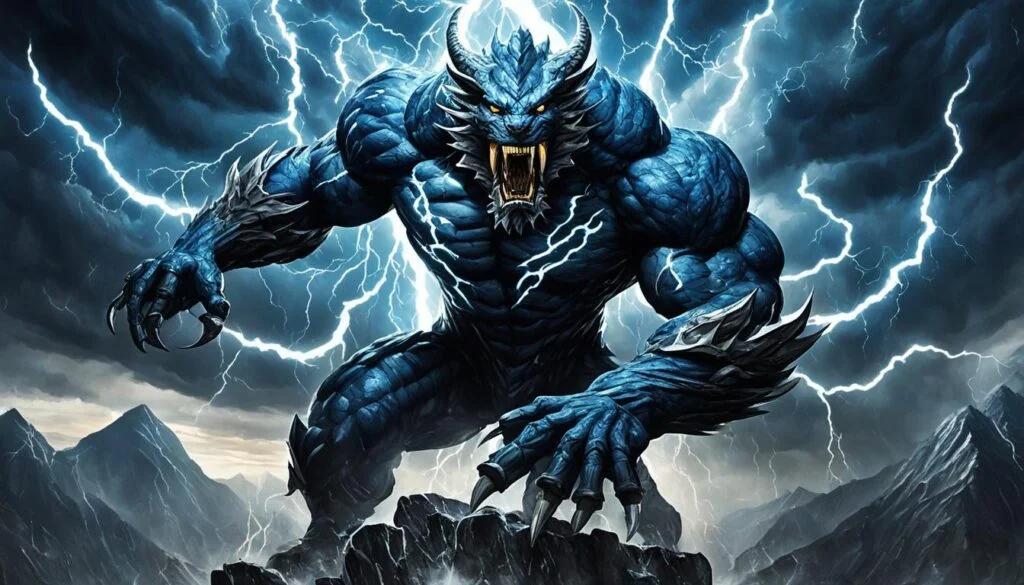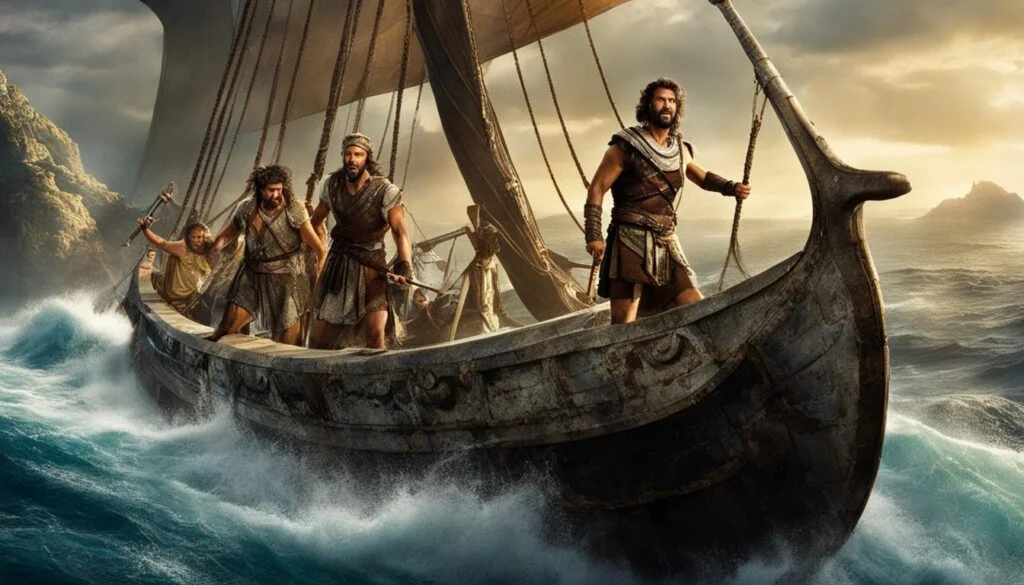Enter the realm of Greek mythology and encounter the mighty Typhon, a monstrous giant serpent-like creature with a history shrouded in power and mystery. Who is Typhon in Greek mythology? What is his story, his origin, and the extent of his powers? Join us as we delve into the captivating world of Typhon and explore the secrets behind his fearsome reputation.
Key Takeaways:
- Typhon, also known as Typhoeus, is a monstrous giant serpent-like creature in Greek mythology.
- He is believed to be the offspring of either Gaia and Tartarus or Hera and Cronus.
- Typhon challenged Zeus for cosmic power but was ultimately defeated and banished to Tartarus or entombed under Mount Etna or the island of Ischia.
- His terrifying physical description includes a hundred heads with fire-emitting serpents.
- Typhon’s unique nature defies categorization as either god or human.
The Origin of Typhon in Greek Mythology
Typhon, one of the most fearsome creatures in Greek mythology, has a complex and intriguing origin. According to ancient texts, he is believed to be the offspring of Gaia, the Earth, and Tartarus, the Abyss. This union of primordial forces gave birth to a creature of immense power and terror.
However, some variations in mythological accounts suggest different parentage for Typhon. One possibility is that Hera, the Queen of the Gods, and Cronus, the ruler of the Titans, are his parents. This alternative parentage theory adds another dimension to Typhon’s origins and emphasizes the uncertain and enigmatic nature of this monstrous being.
Regardless of his exact parentage, Typhon’s origins reveal the deep connection between the elemental forces of the Earth and the underworld in Greek mythology. His existence as the offspring of such powerful entities solidifies his status as a formidable adversary and a force to be reckoned with.
The Mythology of Typhon in Greek Mythology
Typhon, also known as Typhoeus, Typhaon, Typhos, Typho, and other names, is described as a massive serpent-like monster and one of the deadliest creatures in Greek mythology. He is known for challenging Zeus and seeking to overthrow him and seize control of the cosmos.
- Legend has it that Typhon was born from the union of Gaia, the Earth, and Tartarus, the Abyss. Some variations of the myth suggest that Hera, the Queen of the Gods, or Cronus, the Titan ruler, may have been his parents.
- Typhon’s ferocious nature and immense power made him a formidable adversary to the gods. With his hundred fire-emitting serpent heads, he instilled fear and chaos wherever he went.
- His audacious quest to challenge Zeus and claim dominion over the heavens and the earth led to a cataclysmic battle between the two powerful entities.
- During their epic clash, thunderbolts collided with Typhon’s wild energy, causing destructive storms and earth-shaking tremors that threatened the very fabric of existence.
Despite the strength and cunning of Typhon, Zeus ultimately emerged victorious, defeating the monstrous creature and preserving his reign as the ruler of the gods.
To this day, the story of Typhon continues to captivate and fascinate, showcasing the enduring power of Greek mythology and the ever-present battle between chaos and order.
Typhon’s Battle with Zeus
Typhon, the monstrous serpent-like creature from Greek mythology, dared to challenge Zeus, the ruler of the gods. In a cataclysmic battle, Typhon sought to overthrow Zeus and seize control of the cosmos. The battle between these two powerful entities resulted in chaos and destruction.
Zeus, known for his thunderbolts and divine might, faced the formidable threat of Typhon head-on. The clash of their immense powers ignited cataclysmic storms and unleashed devastating earthquakes that shook the heavens and the earth.
As the battle raged on, Thunderbolts collided with Typhon’s wild, untamed energy, creating an awe-inspiring display of power. The heavens lit up with lightning, thunder reverberated through the air, and the earth trembled under the fierce blows exchanged between Zeus and Typhon.
In their epic confrontation, Zeus emerged as the victor, harnessing the full force of his thunderbolts to deliver a final, devastating blow to Typhon. The monstrous creature was defeated, his rebellion quelled by the might of Zeus.
The aftermath of the battle left a trail of destruction in its wake, showcasing the immense power and ferocity of both Typhon and Zeus. However, it was Zeus who prevailed and retained his position as the supreme ruler of the gods.
The Cataclysmic Battle between Typhon and Zeus
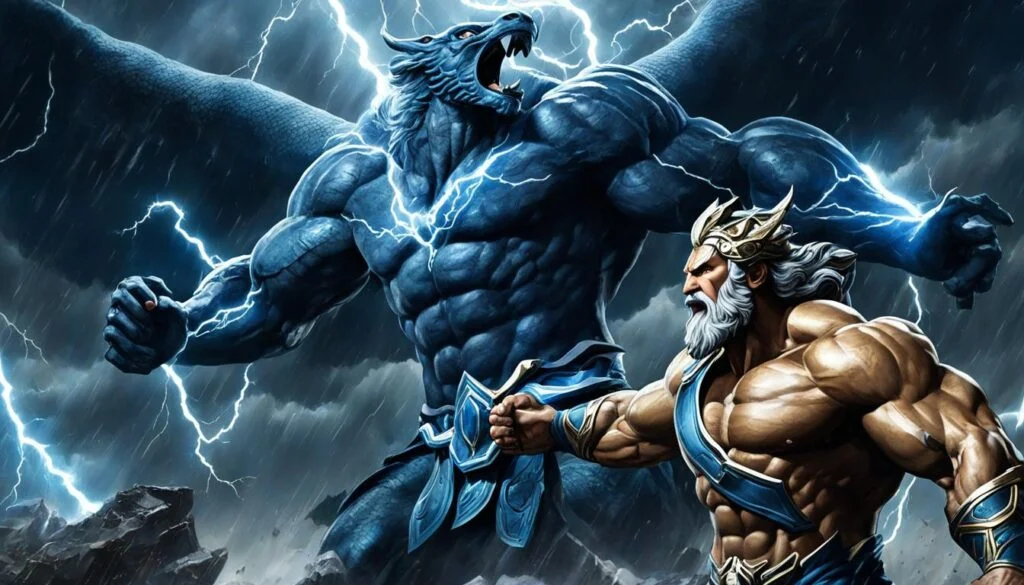
The clash between Typhon and Zeus was an awe-inspiring spectacle that reverberated through the heavens and the earth. With his hundred fire-emitting serpent heads and unimaginable strength, Typhon launched a ferocious assault on Zeus, determined to usurp his divine rule.
In this cataclysmic battle, the sheer power of Thunderbolts clashed with Typhon’s wild and untamed energy, unleashing devastating storms and earth-shattering tremors. The world quaked beneath their titanic struggle as chaos and destruction unfolded.
The thunderous roar of Zeus’s might mingled with Typhon’s vicious onslaught, echoing throughout the cosmos. With each clash, the very fabric of reality seemed to tremble, as though the gods themselves were on the brink of annihilation.
As Zeus hurled his lightning bolts, Typhon fought back with unrivaled strength, refusing to yield. The clash of these mighty adversaries held the world in thrall, as their epic struggle shook the foundations of the universe.
Inspired by the gods’ battle, the elements themselves seemed to take sides. Storm clouds converged, lightning rent the skies, and the earth convulsed in response to the tremendous forces unleashed by Typhon and Zeus.
The cataclysmic battle between Typhon and Zeus left an indelible mark on ancient mythology, forever etching the tale of their fierce conflict in the annals of history.
Zeus’ Victory and the Defeat of Typhon
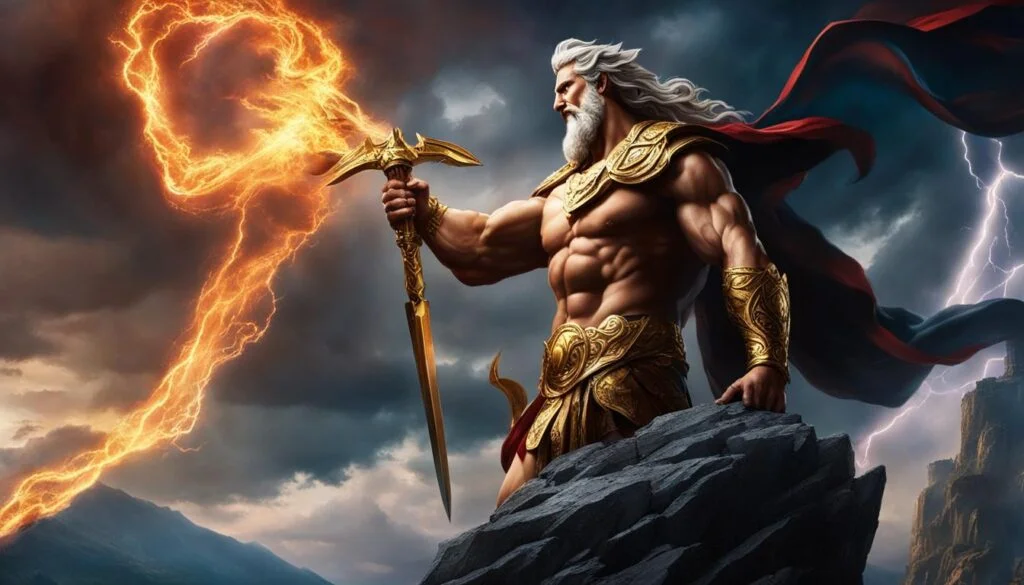
Once the cataclysmic battle between Zeus and Typhon reached its climax, it was Zeus, the mighty ruler of the gods, who emerged as the victor. With his divine might and mastery over thunderbolts, Zeus delivered a final, devastating blow to Typhon, overpowering the monstrous creature and sealing its defeat.
The defeat of Typhon by Zeus marked a significant turning point in the ancient Greek mythological narrative. The battle showcased Zeus’ unparalleled power and strength, solidifying his position as the supreme ruler of the cosmos. It also served as a testament to the triumph of order and civilization over chaos and destruction, reinforcing the prevailing themes in Greek mythology.
According to different versions of the myth, Typhon faced two possible fates after his defeat. In some accounts, he was cast into the dark abyss of Tartarus, the deepest part of the Underworld where the most malevolent beings were imprisoned. In others, Typhon suffered the weight of Mount Etna, a colossal volcano located in Sicily, as it stood as a monument to his defeat, forever overshadowing his monstrous legacy.
The defeat of Typhon by Zeus not only secured the reign of the Olympian gods but also highlighted the indomitable power of Zeus himself. It solidified his status as the supreme deity in Greek mythology and reaffirmed his authority over the natural and supernatural realms.
Typhon’s Physical Description
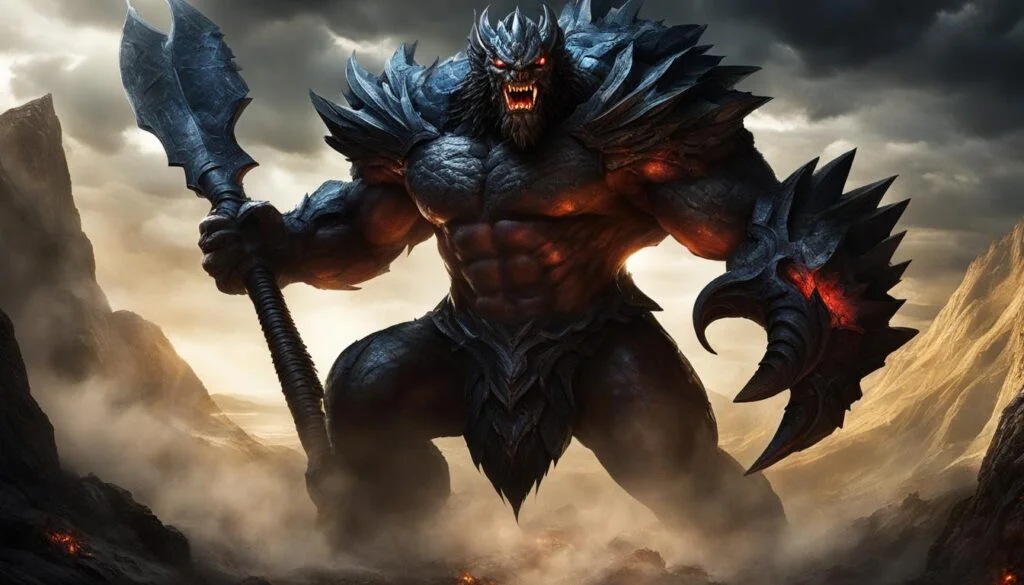
Typhon, the formidable creature from Greek mythology, possesses a terrifying physical appearance that instilled fear and dread in the hearts of even the most courageous heroes. Described as a fire-emitting serpent with a hundred heads, each head emits flames and produces ominous noises, adding to the aura of dread surrounding this monstrous titan. But the menace doesn’t end there.
Depictions of Typhon often show him with serpent legs, fiery eyes that pierce through darkness, and enormous hands adorned with fifty serpentine fingers. This grotesque combination of features further highlights the nightmarish nature of Typhon.
To truly grasp the magnitude of Typhon’s terrifying form, picture a creature whose very presence engenders chaos and destruction. Visualize the hundred heads spewing forth flames, the serpent legs slithering through the earth, and the fiery eyes blazing with an unquenchable rage. It is no wonder that Typhon stands as one of Greek mythology’s most feared and monstrous beings.
Monstrous Attributes of Typhon:
- A fire-emitting serpent with a hundred heads
- Each head emits flames and produces ominous noises
- Serpent legs
- Fiery eyes
- Enormous hands with fifty serpentine fingers
Typhon’s physical attributes evoke a sense of dread, underscoring his power and ferocity. His monstrous form further contributes to his unique position in Greek mythology, defying categorization as either god or human.
Typhon’s Unique and Ferocious Nature
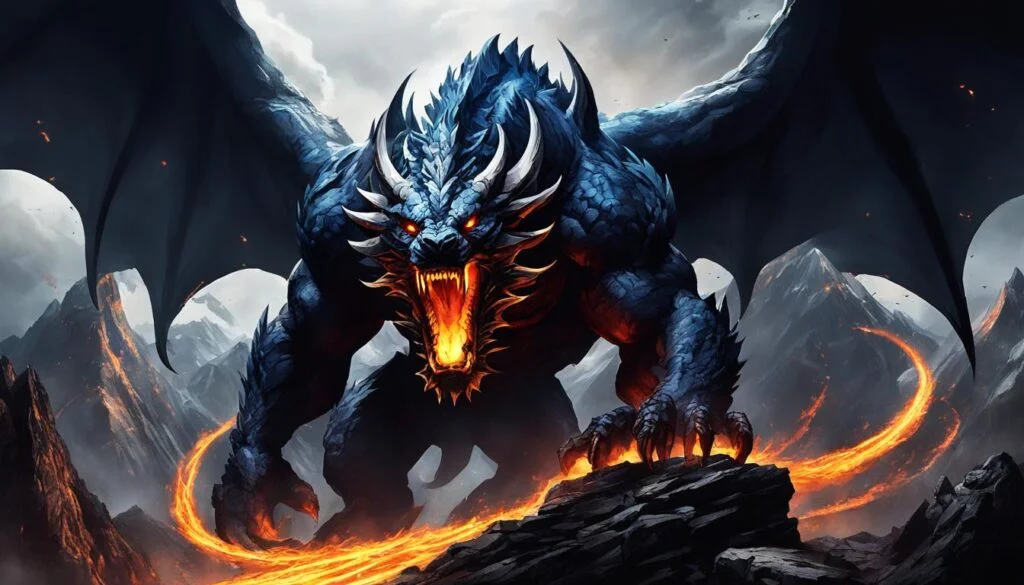
Typhon, the monstrous giant serpent-like creature in Greek mythology, possesses a nature that eludes conventional classification. Neither fully god nor entirely human, he exists in a realm of his own, embodying ferocity and cruelty. With his monstrous demeanor and immense strength, Typhon stands as a force to be reckoned with, his unique attributes transcending mortal and divine distinctions.
This fierce titan’s nature is characterized by his unrivaled power and untamed wildness. Typhon’s very presence strikes fear into the hearts of those who encounter him, as he embodies the essence of chaos and destruction. In his monstrous form, he is described as a fire-emitting serpent with a hundred heads, each emitting flames and resounding with ominous noises. His eyes blaze with the fury of an inferno, reflecting his uncontrollable rage.
Unlike the gods of Olympus or mortal humans, Typhon possesses an unmatched strength that is both awe-inspiring and terrifying. With his serpent legs and fifty serpentine fingers on each hand, he can unleash devastation on a massive scale. Typhon’s physical prowess allows him to challenge even the most powerful deities, defying their authority and seeking to claim dominion over the cosmos.
This striking image serves as a visual representation of Typhon’s extraordinary nature. The ferocious titan looms in the center, capturing the essence of his terrifying power and monstrous attributes. The image further reinforces the descriptions of his formidable strength and relentless nature as he seeks to overpower the gods.
Typhon’s Offspring and Legacy
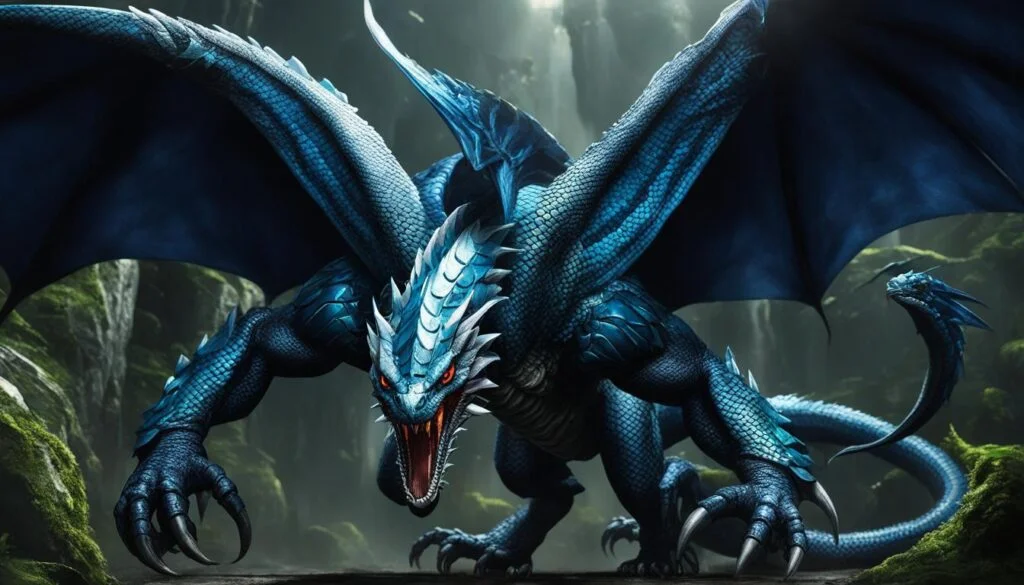
Typhon, the fearsome giant serpent-like creature in Greek mythology, and his companion Echidna are the parents of a multitude of legendary creatures that continue to captivate our imagination.
Among Typhon’s monstrous offspring are:
- The Chimera, a fearsome creature with the head of a lion, the body of a goat, and the tail of a serpent.
- The Sphinx, a majestic creature with the head of a human and the body of a lion.
- The Nemean Lion, a formidable beast with impenetrable golden fur.
- The Hydra of Lerna, a multi-headed serpentine monster known for its regenerative abilities.
- The Tifones, a group of terrifying giants who challenged the Olympian gods.
These creatures embody the ferocity and power inherited from their monstrous parents, perpetuating the legacy of Typhon and Echidna in Greek mythology.
It is worth noting that Typhon’s story also shares parallels with the Egyptian god Seth, emphasizing the interconnectedness and shared themes between ancient mythologies.
Typhon’s Imprisonment and Aftermath
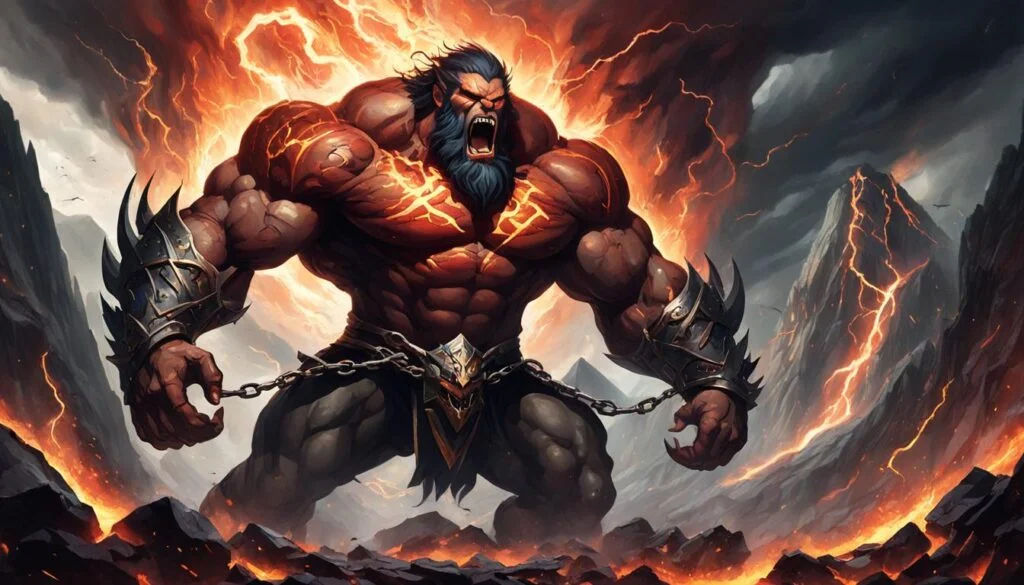
After his defeat by Zeus, Typhon faced a grim fate. There are conflicting accounts of his imprisonment, with some sources stating that he was cast into Tartarus, the deepest part of the underworld, while others suggest that he was entangled under Mount Etna. The exact nature of Typhon’s punishment remains a subject of debate among scholars.
The legend of Typhon’s imprisonment under Mount Etna gained popularity in Greek mythology and later became associated with the volcanic activity of the region. According to this version, Typhon is trapped underneath the weight of the mighty mountain, forever tormented by his defeat and the wrath of Zeus.
The Heroic Intervention
In some accounts, the hero Herakles (Heracles) played a crucial role in Typhon’s imprisonment. It is said that Herakles intervened to protect Zeus when Typhon launched his assault against the ruler of the gods. Using his immense strength and bravery, Herakles fought alongside Zeus and ultimately played a part in Typhon’s defeat.
Release and Aftermath
Despite his imprisonment, Typhon’s menacing presence continued to be felt throughout mythology. His monstrous children, born from his union with Echidna, carried on his legacy of chaos and destruction. Creatures like the Chimera, the Sphinx, the Nemean Lion, the Hydra of Lerna, and others became notorious for their ferocity and posed formidable challenges to heroes in their quests.
While Typhon remains confined, his influence and the specter of his rebellion against the gods continue to captivate the imaginations of storytellers and enthusiasts of Greek mythology.
Prometheus and Typhon’s Connection
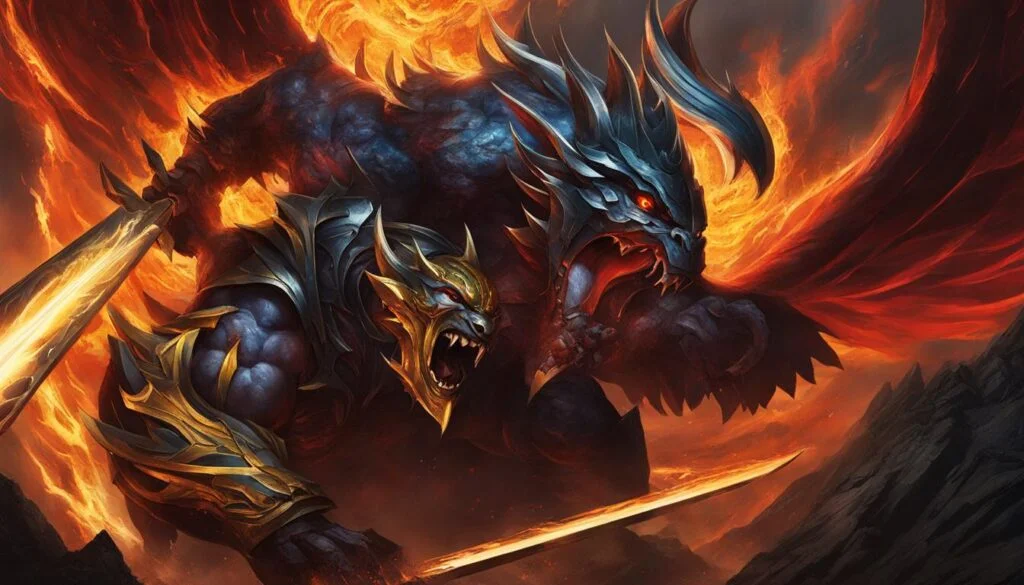
Prometheus, a Titan god of Greek mythology, shares a compelling connection with Typhon, the monstrous serpent-like creature. Both Prometheus and Typhon are renowned for their rebellious nature and defiance against the authority of the gods, which ultimately led to their punishment.
Prometheus is often loosely associated with the fire-god Hephaistos and the giant Tityos. Similarly, Typhon challenged the dominance of Zeus, the ruler of the gods, in a cataclysmic battle for cosmic power. This connection between Prometheus and Typhon highlights their shared themes of defiance and the consequences they faced for their audacious actions.
Continue reading to discover more about the captivating mythology surrounding Prometheus and Typhon’s extraordinary stories.
Conclusion
In Greek mythology, Typhon, the monstrous giant serpent-like creature, was a powerful force that challenged the authority of Zeus, the ruler of the gods. Despite his fierce power and cataclysmic battle, Typhon was ultimately defeated by Zeus. However, Typhon’s legacy lives on through his monstrous offspring and his enduring presence in literature, films, and popular culture.
Typhon’s physical description as a fire-emitting serpent with a hundred heads and his unique nature that defies categorization continue to captivate the imagination of people. His offspring, such as the Chimera and Hydra of Lerna, further contribute to the rich tapestry of Greek mythology.
The story of Typhon serves as a reminder of the struggle between order and chaos, highlighting the power and resilience of the gods. It also showcases the interconnectedness of ancient mythologies, as Typhon shares similarities with the Egyptian god Seth.
In conclusion, Typhon’s mythology remains an enthralling and enduring part of Greek folklore. His rebellion against Zeus and the subsequent defeat symbolize the triumph of divine power over chaos. The legacy of Typhon continues to inspire and fascinate, reminding us of the timeless allure of ancient myths.
FAQ
Who is Typhon in Greek mythology?
Typhon, also known as Typhoeus, is a monstrous giant serpent-like creature in Greek mythology.
What are some facts about Typhon?
Typhon challenged Zeus for cosmic power, was defeated and banished to Tartarus, and is the parent of many well-known monsters.
What is the story behind Typhon?
Typhon is believed to be the offspring of Gaia and Tartarus, or possibly Hera or Cronus, and he sought to overthrow Zeus and seize control of the cosmos.
What were Typhon’s powers?
Typhon was described as a fire-emitting serpent with a hundred heads and immense strength.
How was Typhon defeated?
Zeus emerged victorious from the battle with Typhon, delivering a final, devastating blow with his thunderbolts.
What does Typhon look like?
Typhon has a hundred heads with fire-emitting serpents, serpent legs, fiery eyes, and enormous hands with fifty serpentine fingers.
How would you describe Typhon’s nature?
Typhon’s nature defies categorization as either a god or a human, embodying ferocity and cruelty.
Who are Typhon’s children?
Typhon and his companion Echidna are the parents of various legendary creatures, including the Chimera, the Sphinx, the Nemean Lion, the Hydra of Lerna, and the tifones.
What happened to Typhon after his defeat?
There are conflicting accounts of Typhon’s imprisonment, with some sources stating he was cast into Tartarus and others suggesting he was buried beneath Mount Etna.
Is there a connection between Prometheus and Typhon?
Both Prometheus and Typhon are rebellious figures who challenged the authority of the gods and suffered punishment for their defiance.
What is the legacy of Typhon in Greek mythology?
Typhon’s legacy lives on through his monstrous offspring and the continued fascination with his mythology in literature, films, and popular culture.


